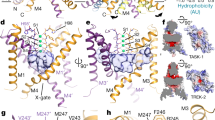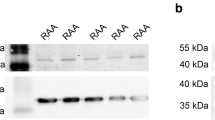Abstract
Atrial fibrillation and obstructive sleep apnea are responsible for significant morbidity and mortality in the industrialized world. There is a high medical need for novel drugs against both diseases, and here, Kv1.5 channels have emerged as promising drug targets. In humans, TASK-1 has an atrium-specific expression and TASK-1 is also abundantly expressed in the hypoglossal motor nucleus. We asked whether known Kv1.5 channel blockers, effective against atrial fibrillation and/or obstructive sleep apnea, modulate TASK-1 channels. Therefore, we tested Kv1.5 blockers with different chemical structures for their TASK-1 affinity, utilizing two-electrode voltage clamp (TEVC) recordings in Xenopus oocytes. Despite the low structural conservation of Kv1.5 and TASK-1 channels, we found all Kv1.5 blockers analyzed to be even more effective on TASK-1 than on Kv1.5. For instance, the half-maximal inhibitory concentration (IC50) values of AVE0118 and AVE1231 (A293) were 10- and 43-fold lower on TASK-1. Also for MSD-D, ICAGEN-4, S20951 (A1899), and S9947, the IC50 values were 1.4- to 70-fold lower than for Kv1.5. To describe this phenomenon on a molecular level, we used in silico models and identified unexpected structural similarities between the two drug binding sites. Kv1.5 blockers, like AVE0118 and AVE1231, which are promising drugs against atrial fibrillation or obstructive sleep apnea, are in fact potent TASK-1 blockers. Accordingly, block of TASK-1 channels by these compounds might contribute to the clinical effectiveness of these drugs. The higher affinity of these blockers for TASK-1 channels suggests that TASK-1 might be an unrecognized molecular target of Kv1.5 blockers effective in atrial fibrillation or obstructive sleep apnea.





Similar content being viewed by others
References
Bachmann A, Gutcher I, Kopp K, Brendel J, Bosch RF, Busch AE, Gogelein H (2001) Characterization of a novel Kv1.5 channel blocker in Xenopus oocytes, CHO cells, human and rat cardiomyocytes. Naunyn Schmiedebergs Arch Pharmacol 364:472–478
Bayliss DA, Sirois JE, Talley EM (2003) The TASK family: two-pore domain background K+ channels. Mol Interv 3:205–219
Burashnikov A, Di Diego JM, Zygmunt AC, Belardinelli L, Antzelevitch C (2007) Atrium-selective sodium channel block as a strategy for suppression of atrial fibrillation: differences in sodium channel inactivation between atria and ventricles and the role of ranolazine. Circulation 116:1449–1457
Burashnikov A, Barajas-Martinez H, Hu D, Nof E, Blazek J, Antzelevitch C (2012) Atrial-selective prolongation of refractory period with AVE0118 is due principally to inhibition of sodium channel activity. J Cardiovasc Pharmacol 59:539–546
Campagna-Slater V, Arrowsmith AG, Zhao Y, Schapira M (2010) Pharmacophore screening of the protein data bank for specific binding site chemistry. J Chem Inf Model 50:358–367
Christ T, Wettwer E, Voigt N, Hala O, Radicke S, Matschke K, Varro A, Dobrev D, Ravens U (2008) Pathology-specific effects of the I Kur/I to/I K,ACh blocker AVE0118 on ion channels in human chronic atrial fibrillation. Br J Pharmacol 154:1619–1630
Cotten JF, Keshavaprasad B, Laster MJ, Eger EI 2nd, Yost CS (2006) The ventilatory stimulant doxapram inhibits TASK tandem pore (K2P) potassium channel function but does not affect minimum alveolar anesthetic concentration. Anesth Analg 102:779–785
Decher N, Kumar P, Gonzalez T, Pirard B, Sanguinetti MC (2006) Binding site of a novel Kv1.5 blocker: a “foot in the door” against atrial fibrillation. Mol Pharmacol 70:1204–1211
Decher N, Pirard B, Bundis F, Peukert S, Baringhaus KH, Busch AE, Steinmeyer K, Sanguinetti MC (2004) Molecular basis for Kv1.5 channel block: conservation of drug binding sites among voltage-gated K+ channels. J Biol Chem 279:394–400
Decher N, Streit AK, Rapedius M, Netter MF, Marzian S, Ehling P, Schlichthörl G, Craan T, Renigunta V, Köhler A, Dodel RC, Navarro-Polanco RA, Preisig-Müller R, Klebe G, Budde T, Baukrowitz T, Daut J (2010) RNA editing modulates the binding of drugs and highly unsaturated fatty acids to the open pore of Kv potassium channels. EMBO J 29:2101–2113
Dobrev D, Friedrich A, Voigt N, Jost N, Wettwer E, Christ T, Knaut M, Ravens U (2005) The G protein-gated potassium current IK, ACh is constitutively active in patients with chronic atrial fibrillation. Circulation 112:3697–3706
Fedida D, Wible B, Wang Z, Fermini B, Faust F, Nattel S, Brown AM (1993) Identity of a novel delayed rectifier current from human heart with a cloned K+ channel current. Circ Res 73:210–216
Gardener MJ, Johnson IT, Burnham MP, Edwards G, Heagerty AM, Weston AH (2004) Functional evidence of a role for two-pore domain potassium channels in rat mesenteric and pulmonary arteries. Br J Pharmacol 142:192–202
Gögelein H, Brendel J, Steinmeyer K, Strübing C, Picard N, Rampe D, Kopp K, Busch AE, Bleich M (2004) Effects of the atrial antiarrhythmic drug AVE0118 on cardiac ion channels. Naunyn Schmiedebergs Arch Pharmacol 370:183–192
Jiang Y, Lee A, Chen J, Cadene M, Chait BT, MacKinnon R (2002) Crystal structure and mechanism of a calcium-gated potassium channel. Nature 417:515–522
Knobloch K, Brendel J, Peukert S, Rosenstein B, Busch AE, Wirth KJ (2002) Electrophysiological and antiarrhythmic effects of the novel I Kur channel blockers, S9947 and S20951, on left vs. right pig atrium in vivo in comparison with the I Kr blockers dofetilide, azimilide, d,l-sotalol and ibutilide. Naunyn Schmiedebergs Arch Pharmacol 366:482–487
Knobloch K, Brendel J, Rosenstein B, Bleich M, Busch AE, Wirth KJ (2004) Atrial-selective antiarrhythmic actions of novel I Kur vs. I Kr, I Ks, and I KAch class Ic drugs and beta blockers in pigs. Med Sci Monit 10:BR221–BR228
Kun A, Seprenyi G, Varro A, Papp JG, Pataricza J (2014) Neurogenic contraction induced by the antiarrhythmic compound, AVE0118, in rat small mesenteric arteries. Basic Clin Pharmacol Toxicol 115:315–320
Li GR, Feng J, Yue L, Carrier M, Nattel S (1996) Evidence for two components of delayed rectifier K+ current in human ventricular myocytes. Circ Res 78:689–696
Limberg SH, Netter MF, Rolfes C, Rinné S, Schlichthörl G, Zuzarte M, Vassiliou T, Moosdorf R, Wulf H, Daut J, Sachse FB, Decher N (2011) TASK-1 channels may modulate action potential duration of human atrial cardiomyocytes. Cell Physiol Biochem 28:613–624
Long SB, Campbell EB, Mackinnon R (2005) Crystal structure of a mammalian voltage-dependent Shaker family K+ channel. Science 309:897–903
Miller AN, Long SB (2012) Crystal structure of the human two-pore domain potassium channel K2P1. Science 335:432–436
Nattel S, Maguy A, Le Bouter S, Yeh YH (2007) Arrhythmogenic ion-channel remodeling in the heart: heart failure, myocardial infarction, and atrial fibrillation. Physiol Rev 87:425–456
Pathak MM, Yarov-Yarovoy V, Agarwal G, Roux B, Barth P, Kohout S, Tombola F, Isacoff EY (2007) Closing in on the resting state of the Shaker K+ channel. Neuron 56:124–140
Petric S, Clasen L, van Wessel C, Geduldig N, Ding Z, Schullenberg M, Mersmann J, Zacharowski K, Aller MI, Schmidt KG, Donner BC (2012) In vivo electrophysiological characterization of TASK-1 deficient mice. Cell Physiol Biochem 30:523–537
Piechotta PL, Rapedius M, Stansfeld PJ, Bollepalli MK, Ehrlich G, Andres-Enguix I, Fritzenschaft H, Decher N, Sansom MS, Tucker SJ, Baukrowitz T (2011) The pore structure and gating mechanism of K2P channels. EMBO J 30:3607–3619
Putzke C, Wemhöner K, Sachse FB, Rinné S, Schlichthörl G, Li XT, Jae L, Eckhardt I, Wischmeyer E, Wulf H, Preisig-Müller R, Daut J, Decher N (2007) The acid-sensitive potassium channel TASK-1 in rat cardiac muscle. Cardiovasc Res 75:59–68
Rapedius M, Schmidt MR, Sharma C, Stansfeld PJ, Sansom MS, Baukrowitz T, Tucker SJ (2012) State-independent intracellular access of quaternary ammonium blockers to the pore of TREK-1. Channels (Austin) 6:473–478
Sali A, Blundell TL (1993) Comparative protein modelling by satisfaction of spatial restraints. J Mol Biol 234:779–815
Streit AK, Netter MF, Kempf F, Walecki M, Rinné S, Bollepalli MK, Preisig-Müller R, Renigunta V, Daut J, Baukrowitz T, Sansom MS, Stansfeld PJ, Decher N (2011) A specific two-pore domain potassium channel blocker defines the structure of the TASK-1 open pore. J Biol Chem 286:13977–13984
Strutz-Seebohm N, Gutcher I, Decher N, Steinmeyer K, Lang F, Seebohm G (2007) Comparison of potent Kv1.5 potassium channel inhibitors reveals the molecular basis for blocking kinetics and binding mode. Cell Physiol Biochem 20:791–800
Talley EM, Lei Q, Sirois JE, Bayliss DA (2000) TASK-1, a two-pore domain K+ channel, is modulated by multiple neurotransmitters in motoneurons. Neuron 25:399–410
Tarasiuk A, Reuveni H (2013) The economic impact of obstructive sleep apnea. Curr Opin Pulm Med 19:639–644
Van Wagoner DR, Pond AL, McCarthy PM, Trimmer JS, Nerbonne JM (1997) Outward K+ current densities and Kv1.5 expression are reduced in chronic human atrial fibrillation. Circ Res 80:772–781
Wang Z, Fermini B, Nattel S (1993) Sustained depolarization-induced outward current in human atrial myocytes. Evidence for a novel delayed rectifier K+ current similar to Kv1.5 cloned channel currents. Circ Res 73:1061–1076
Wirth KJ, Steinmeyer K, Ruetten H (2013) Sensitization of upper airway mechanoreceptors as a new pharmacologic principle to treat obstructive sleep apnea: investigations with AVE0118 in anesthetized pigs. Sleep 36:699–708
Wirth KJ, Brendel J, Steinmeyer K, Linz DK, Rütten H, Gogelein H (2007) In vitro and in vivo effects of the atrial selective antiarrhythmic compound AVE1231. J Cardiovasc Pharmacol 49:197–206
Wolf PA, Mitchell JB, Baker CS, Kannel WB, D’Agostino RB (1998) Impact of atrial fibrillation on mortality, stroke, and medical costs. Arch Intern Med 158:229–234
Acknowledgments
We thank Oxana Nowak for excellent technical support. We are grateful to Klaus Steinmeyer, Klaus Wirth, and Heinz Gögelein from Sanofi-Aventis for the support in our studies. This work was supported by a grant of the Deutsche Forschungsgemeinschaft (DE-1482/3-1 and DE-1482/3-2 to N.D.) and the Anneliese Pohl Habilitationsförderung der Anneliese Pohl Stiftung to S.R.
Conflict of interest
The authors have no competing financial interests.
Author information
Authors and Affiliations
Corresponding author
Additional information
Aytug K. Kiper, Susanne Rinné, and Caroline Rolfes contributed equally.
This article is published as part of the Special Issue on K2P channels.
Rights and permissions
About this article
Cite this article
Kiper, A.K., Rinné, S., Rolfes, C. et al. Kv1.5 blockers preferentially inhibit TASK-1 channels: TASK-1 as a target against atrial fibrillation and obstructive sleep apnea?. Pflugers Arch - Eur J Physiol 467, 1081–1090 (2015). https://doi.org/10.1007/s00424-014-1665-1
Received:
Revised:
Accepted:
Published:
Issue Date:
DOI: https://doi.org/10.1007/s00424-014-1665-1




